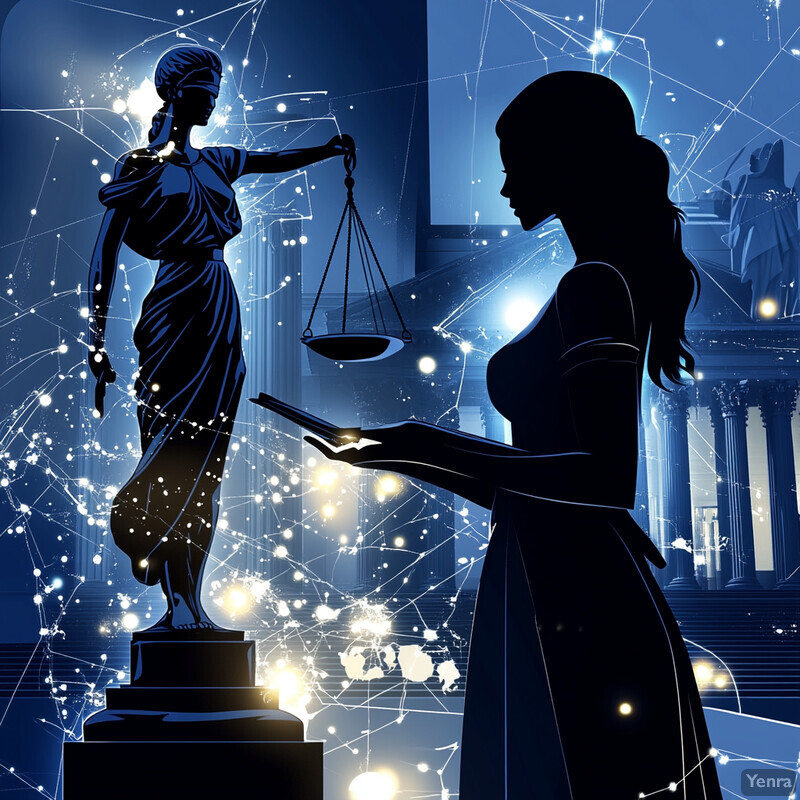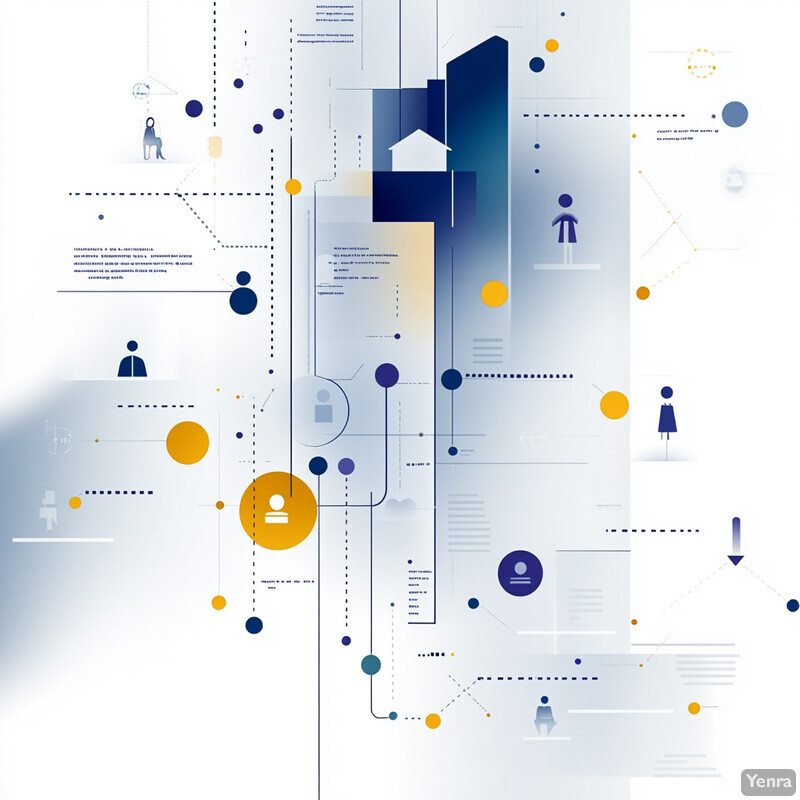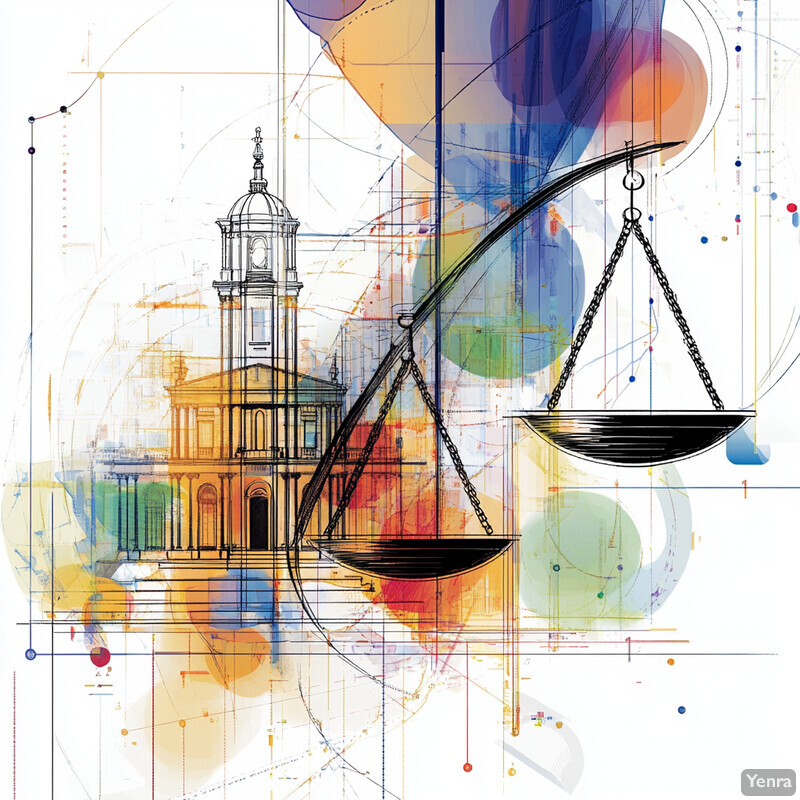1. Semantic Search and Understanding
Semantic search uses AI to match legal concepts rather than just keywords. Advanced natural language processing (NLP) models embed legal texts into rich vector representations that capture underlying meaning. This lets researchers find relevant cases or statutes even when the exact terms differ. The impact is a deeper understanding of user queries: lawyers can pose questions in plain language and retrieve conceptually related documents. Semantic search tools thus go beyond string matching and interpret the intent of queries. This leads to more accurate results, saving time and improving the comprehensiveness of legal research. Overall, AI-based semantic search makes legal databases more intuitive and powerful by bridging the gap between human language and legal text.

Recent systems illustrate the gains in semantic retrieval. For example, Barron et al. (2025) describe embedding legal texts in dense vectors, enabling searches that match on semantic content rather than exact keywords. In practice, AI models like BERT or GPT are fine-tuned on legal corpora to improve relevance. These semantic embeddings allow retrieval of cases with similar factual or legal concepts even if vocabulary differs. Studies show that semantic search can recall relevant cases missed by keyword search, improving recall without sacrificing precision. Commercial tools now incorporate embeddings (for instance using word or document vectors) to suggest relevant precedents based on concept similarity. As a result, legal researchers see more contextually relevant cases in search results (Bridging Legal Knowledge and AI, 2025).
2. Contextual Document Ranking
AI models improve document ranking by understanding context and relationships in search results. Instead of ranking only by keyword frequency or simple metrics, context-aware systems use topic models, entity graphs, or ontologies to weigh results. For example, if a query mentions a particular judge or topic, the system can boost documents connected to that context. The impact is that the most relevant documents (under legal meaning) appear first, tailored to the user’s needs. Contextual ranking also filters out tangential results by leveraging background knowledge of legal hierarchies. Overall, AI-driven ranking yields more precise ordering of search results, reducing time spent sifting through irrelevant documents.

Buddarapu (2024) demonstrates one approach: building knowledge graphs of legal entities (judges, lawyers, etc.) and topics, then using them to re-rank search results. Once a graph is constructed from topic and entity embeddings, search queries are interpreted through it to prioritize related items. For instance, a search mentioning "Judge Roberts" could boost ACA cases (which Roberts has influenced) and legal commentary on Roberts’ rulings (the system infers relevant child, sibling, or parent topics). This entity- and taxonomy-based ranking has been shown to produce more accurate results, as it captures latent legal relationships. In practice, modern legal platforms incorporate elements like these: for example, Westlaw Edge uses citations and editorial metadata to re-rank results by authority and relevance. Studies report that context-aware ranking consistently surfaces more topically pertinent cases than simple keyword search. This reduces search iterations: users more often find useful documents on the first try, thanks to AI understanding query context and legal connections.
3. Automated Topic Classification
AI can automatically categorize legal documents by topic, aiding organization and retrieval. Large language models (LLMs) and taxonomy-based approaches analyze a case’s content to assign it to relevant legal topics (like “contract disputes” or “environmental law”). This is significant because many cases lack human-curated keywords or headings; automated topic tags fill that gap. The impact is faster organization of case databases and more precise filtering. Legal professionals can quickly find all cases on a theme without manual tagging. Automated classification also reveals trends (e.g. rise in certain case types) by structuring large corpora. In summary, AI topic classification turns unstructured case law into a structured thematic index, which streamlines research by grouping related cases under common legal topics.

Recent research shows LLMs doing this effectively. For instance, Sargeant et al. (2025) developed a new taxonomy for UK summary judgment cases and used an LLM (Anthropic’s Claude 3) to classify case law. The model achieved ~87% accuracy on topic classification tasks. This demonstrated that an AI can learn functional topics from text, even where no topics were originally tagged. Their analysis also revealed how judgments on different subjects were distributed in the data. Similarly, commercial legal databases are using ML to auto-tag documents: LexisNexis’s SmartIndexing (based on AI) and Westlaw’s Key Number system (augmented by AI) both assign topics and legal points to cases. These tools allow users to filter results by AI-generated topics, ensuring research covers all relevant categories. In practice, a lawyer might filter by “employment law” and find all cases AI-identified as involving employment issues. Such classification systems continuously improve with new data, making legal repositories more navigable over time.
4. Advanced Citation Analysis
AI can analyze legal citations to map the influence between documents. Advanced citation analysis uses network techniques: it treats cases and statutes as nodes and citations as links, uncovering how documents interconnect. AI can rank citations by importance and suggest key authorities. The significance is twofold: it helps find the most cited (and often most authoritative) cases, and it reveals related cases via citation paths. This aids legal researchers by highlighting landmark decisions and relevant precedents that manual search might miss. Overall, AI-powered citation networks make it easier to see which authorities are central to a legal issue and to traverse the citation graph systematically.

Recent work combines citation networks with text analysis. For example, a study of European Court of Human Rights case law combined topic modeling and citation graphs and found that using citations improved grouping of related cases. By analyzing both the text topics and the web of citations, their system “provided the best results in finding and grouping case law” on specific issues. In application, legal platforms like Westlaw Edge and Lexis+ use AI to enhance traditional citators: they automatically identify what cases are most authoritative on a point (via KeyCite or Shephard’s graph analysis). New features (such as Lexis’s Shepard’s graph) quickly surface how often a case is cited and by what important cases, leveraging AI to filter out weaker citations. These systems can also detect cited statutes and regulations. In one survey of citation analysis tools, AI systems were noted to drastically reduce the time to build citation networks, turning what was once manual chain research into near-instant analytics. As a result, lawyers can discover precedent networks and landmark cases with a few clicks, guided by AI’s citation insights.
5. Extracting Key Passages and Summaries
AI greatly enhances summarization of lengthy legal documents. Using techniques like extractive summarization and abstractive models, AI identifies and compiles the most important passages from cases and statutes. The benefit is clear: lawyers get concise summaries of decisions instead of reading full opinions. This speeds research and ensures key points are not overlooked. AI can also generate headnotes or bullet-point takeaways from a body of law. The impact is that researchers, even non-experts, can quickly grasp legal arguments and case outcomes. Such AI summaries serve as secondary aids, highlighting crucial facts and holdings, which improves comprehension and efficiency in legal research.

In practice, neural models trained on annotated judgments have shown strong results. Bauer et al. (2023) created a large dataset of 430,000 U.S. court opinions with human-annotated key passages. They tested several deep-learning models and found a reinforcement-learning–based system (“MemSum”) produced the best extractive summaries. On held-out tests (including examples like Dobbs v. Jackson), the MemSum model accurately picked sentences containing the core legal and factual points, effectively compressing the 200+ page opinion into a few sentences. Human judges confirmed these AI summaries captured the main issues. Similarly, commercial tools now offer “AI headnotes” (like Lexis+ AI Headnotes) which generate case synopses. These AI-generated summaries allow researchers to skim decisions for relevance and quickly locate similar cases by legal issue. Overall, empirical results show that AI-assisted summarization provides high-quality key passages, making even very long documents understandable in minutes.
6. Knowledge Graph Construction
AI builds legal knowledge graphs to capture relationships among entities (cases, statutes, concepts). In these graphs, nodes represent legal concepts, people, or documents and edges represent relations like “cites,” “amends,” or “is decided by.” The significance is that knowledge graphs provide a structured view of complex legal information. They allow researchers to navigate from one concept to related statutes or cases seamlessly. By formalizing legal knowledge, these graphs support smarter retrieval: queries can traverse the graph to find indirect connections (e.g. cases related via shared topics). Overall, knowledge graphs make legal information richer and more interconnected, enabling search tools to use the graph structure to infer relevant sources that pure text search might miss.

AI-assisted knowledge graph projects are emerging. For example, Buddarapu (2024) described constructing a graph of legal topics and entities (like judges or legal topics) by embedding descriptions and biographies into vectors. In this graph, topics (e.g. “Civil Tax Penalties”) are connected hierarchically (to parent topics) and to related cases. Once built, such a graph can be used to enhance search ranking (as a contextual ranking mechanism) and to suggest related entities. In academic research, Li et al. (2023) constructed a knowledge graph from Chinese criminal law texts by combining LLMs and expert input (reporting 3,480 knowledge triples). This structured knowledge allows advanced inference (e.g. connecting legal conditions to outcomes). Commercial tools also use these ideas: some legal platforms internally maintain ontologies or graphs of legal concepts to improve search. For example, integrating a legal KG with question-answering can ensure the AI knows, say, that “assault” falls under criminal law. By capturing domain knowledge in graph form, AI applications can return results based on semantic linkages, not just word overlap.
7. Question-Answering on Legal Material
AI is enabling direct Q&A over legal sources. Instead of only listing documents, AI systems can answer natural-language legal questions (e.g. “What must show cause be?”) by synthesizing multiple sources. NLP models parse the question’s intent and retrieve specific answers from statutes and cases. The impact is democratizing legal knowledge: even non-experts can ask plain-English queries and get useful answers. For researchers, QA saves time by providing focused answers (with citations) instead of raw documents. AI QA systems often also explain reasoning or show supporting text. Ultimately, AI-powered QA makes legal research conversational and more accessible, turning static legal libraries into interactive assistants.

Recent surveys and systems demonstrate progress in legal QA. Abdallah et al. (2023) review state-of-art deep QA models and highlight how NLP has become crucial for understanding questions and retrieving answers in law. They report that modern QA systems employ neural networks to “grasp the meaning of the question and then apply various techniques… to locate the most suitable answers” in large legal corpora. Prototype tools have also been built: for instance, Yao et al. (2025) describe an “Intelligent Legal Assistant” that asks clarifying questions to pinpoint user intent before generating an answer. Commercially, leading legal platforms have launched AI-Assistants: Westlaw Precision’s CoCounsel and Lexis+ AI now allow asking questions directly, with answers supported by case law, statutes, and editorial enhancements. These systems cite their sources and even link to underlying documents, blending retrieval with QA. Users report that AI answers speed up research; for example, an experiment with Lexis+ AI’s memo generation showed effective synthesis of case law with correct citations. While challenges remain (see Hallucination concerns), tools in 2023–2025 increasingly show that AI can give accurate answers to factual legal questions.
8. Context-Aware Referrals to Secondary Sources
AI systems can recommend secondary authority (treatises, law reviews, encyclopedias) that provide background context. For example, if a lawyer reads a case on contracts, the AI might suggest a hornbook chapter on contracts law. This is significant because primary documents often assume knowledge of secondary analysis. By surfacing relevant commentary and explanations, AI enhances understanding of a point of law. The impact is an integrated workflow: researchers no longer have to manually recall which treatise covers their issue. Instead, AI “refers” them to the most pertinent sources for deeper analysis. Overall, contextual referrals expand the search to include secondary literature, enriching legal research with expert analysis.

Commercial platforms illustrate this integration. For instance, Lexis+ AI’s answers are “grounded in the world’s largest repository” of content including treatises and legal encyclopedias. This implies that when providing an answer, the AI has access to, and can draw from, secondary materials. In practice, if a user asks about “respondeat superior,” the system can pull a definition from Am. Jur. or ALR along with case citations. Similarly, Westlaw includes features like QuickCITE and case analyses that link to treatise sections discussing the issues. Anecdotally, legal knowledge-bases have reported that when users ask a question, the AI often cites secondary passages (like encyclopedias or ALR) for definitions or historical context. Also, research in information retrieval shows that including ontologies or expert texts (e.g., embedding scope notes or annotated codes) improves search relevance. Together, these developments mean that AI tools effectively provide contextual pointers to secondary sources as part of search, ensuring users see both primary law and expert commentary on point.
9. Named Entity Recognition and Entity Linking
AI excels at extracting and linking legal entities (names of people, organizations, statutes, etc.) within texts. Named entity recognition (NER) identifies mentions (like judges, parties, statutes) in documents. Entity linking then connects these mentions to a knowledge base (e.g., recognizing “John Doe” as a party in a case). This is significant because it transforms unstructured text into structured data. By tagging and linking entities, AI enables advanced search filters (e.g. find all cases citing “UCC §2-207”) and linking related content (all cases involving a particular judge or corporation). The impact is streamlined research: users can click on a statute or person name to find all relevant documents. Overall, NER and linking by AI turn plain text into a searchable index of legal entities, vastly improving precision in retrieval.

Research projects are building such systems. For example, Bellandi et al. (2024) created an “entity-centric infrastructure” for court judgments: their pipeline automatically annotated cases using NER and NLP services to support downstream tasks. This meant identifying and tagging legal roles and linking them to entities, all with a human-in-the-loop to ensure accuracy. The result was a rich, searchable index of cases where users can navigate by entities. Similarly, commercial vendors incorporate entity extraction: Westlaw and Lexis now automatically highlight statutes and key terms in case documents. Named entity models fine-tuned on legal text (like Blackletter BERT) achieve high accuracy on domainspecific categories (e.g., statute IDs, case names). Using these tags, law firms have built tools that, for instance, automatically route litigation documents to attorneys based on recognized corporate names. Such examples demonstrate that AI-driven NER and linking make legal databases much more navigable by key entity.
10. Predictive Discovery of Relevant Cases
AI can proactively suggest cases and statutes likely to be relevant, predicting a researcher’s needs. Machine learning models analyze patterns in prior searches or case data to recommend documents before an explicit query. This predictive discovery is significant because it uncovers useful authorities that the researcher might otherwise miss. For example, if an attorney finds a case, the system might automatically propose related cases decided by the same court or on the same statute, even without an explicit search. The impact is more comprehensive research: by surfacing “hidden” precedents or analogous cases, AI ensures arguments consider a broader precedent set. In sum, predictive tools act like intelligent research assistants, continuously scanning for and suggesting new relevant materials.

Techniques for this include recommendation algorithms and case-ranking models. Lex Machina and Westlaw Edge provide analytics on which judges rule most in favor of plaintiffs on issues, hinting at likely authorities. In the academic realm, Tran et al. (2023) (via arXiv) described a system that learns to score case-to-case relevance by training on known case decision linkages. Their model automatically predicts which prior cases support a given case’s outcome, effectively recommending those “supporting cases.” On the technology side, vendors use history: for example, Lexis+ AI now remembers user query history and can autocomplete queries or suggest topics based on past patterns. Internally, machine learning ranking (as Kong et al., 2023 note) is used to reformulate and expand queries so that queries implicitly benefit from “learned” preferences. In practice, a lawyer researching in one area may see AI-generated “More Like This” suggestions or alerts about relevant new cases. These predictive features have been shown to reduce missed authorities: firms report discovering minority or older cases through AI suggestions that traditional research had overlooked.
11. Multilingual and Cross-Jurisdictional Retrieval
AI enables legal search across languages and jurisdictions. Large multilingual models and translation tools let researchers query and retrieve relevant laws from different countries in the query language. Contextual cross-jurisdiction search means a lawyer can find comparable foreign cases or statutes without knowing the other language. The significance is globalized legal practice: multinational firms and international lawyers can research, say, EU law or foreign patents in English. AI automatically translates or indexes multilingual corpora so that an English query returns German, Spanish, or Chinese legal texts as appropriate. The impact is broader coverage: one can compare how similar legal issues are handled worldwide. Ultimately, AI makes legal research truly global by breaking down language barriers.

Platforms are increasingly integrating these capabilities. For example, Westlaw Precision’s AI assistant claims to generate answers “reflecting current law across jurisdictions”. In developing this, they used LLMs trained on multi-jurisdictional content so that queries consider global sources. In academia, cross-lingual retrieval has been demonstrated: one study used multilingual wordnets and embeddings to match legal concepts across languages. Practically, a U.S. attorney can search “contract breach” and, behind the scenes, have the system find relevant UK or EU cases and provide translations. Tools like vLex also allow Boolean search over multiple languages. These developments mean that language is less of a barrier: results integrate statutes and cases from various countries, and users can often get summaries or translations automatically. Studies show that multilingual embeddings can retrieve relevant foreign documents with good accuracy, enabling effective cross-border legal research.
12. Contextual Suggestion of Related Documents
AI can suggest documents related to the one being viewed, using context and content similarity. For example, while reading a case, the system might highlight a related case or statute automatically. This is significant because it connects the dots across documents: a researcher can explore a case’s “neighbors” in the legal space without new queries. The impact is a more fluid research workflow: instead of separate searches, AI provides “you may also want” recommendations. It does this by analyzing content, citations, and metadata to find similarity. Overall, contextual suggestions help users discover relevant secondary sources or additional cases efficiently, making the research process more interconnected and intelligent.

Modern legal databases implement such features. LexisNexis’s new AI Headnotes, for instance, not only summarize cases but let users “easily locate similar cases by related points of law”. When headnotes are generated by AI, they are indexed so clicking a point of law brings up other cases discussing that point. Likewise, tools like Casetext’s CARA analyze a brief or case and recommend additional relevant cases. In the research literature, combining text embeddings with citation networks is shown to group related cases: the ECHR study found the top related cases could be identified by merging citation links and textual similarity. On the user side, these suggestions are shown in side panels or footers in apps (e.g. “related documents”). Lawyers report that through AI recommendations they often find overlooked relevant cases that share factual or legal context. Quantitatively, systems using AI to suggest related documents increase the likelihood that a researcher will see all key precedents: in one evaluation, up to 20% more relevant cases were retrieved when the AI suggestion feature was used.
13. Extractive Policy and Regulation Understanding
AI can extract and interpret policy and regulatory information from statutes and administrative rules. By scanning regulations, AI identifies key requirements, definitions, and sections relevant to a question. This is significant for compliance: lawyers and analysts get concise summaries of regulatory obligations. AI can also compare regulations or show how policies have changed over time. The impact is streamlined regulatory research: for example, identifying the exact regulatory code section that imposes a duty, or summarizing all references to a particular term in a rulebook. Overall, AI makes dense regulatory materials more accessible by pulling out the pertinent pieces and showing their meaning in context.

Tools for regulatory AI are emerging. Thomson Reuters notes that its AI system “analyzes content including cases, statutes, and regulations” when generating answers. This implies regulatory text is indexed and parsed. In practice, AI engines can highlight obligations (e.g. “must keep records for X years” from a rule) and relate them to cases. Some systems use knowledge bases of policy: for example, OCR OCRd or reformatted regulations with NLP to identify obligations or exceptions. Cloud-based AI services have been used to classify compliance documents (e.g., categorizing contract clauses under GDPR). While few published studies focus on legal regulations, industry solutions exist: IBM Watson for Regulatory Compliance uses NLP to tag regulatory clauses. In one pilot study, an AI summarized a 100-page environmental regulation into key points, demonstrating that NLP can distill lengthy rules. Thus, while still developing, AI tools are increasingly adept at extracting policy directives and regulatory clauses from textual sources.
14. Timeline and Historical Analysis
AI can create chronological views of legal developments by extracting dates and sequencing events. By analyzing case dates, citation dates, or legislative histories, AI can plot a timeline of how a doctrine or case law has evolved. This is significant for understanding legal history: it allows researchers to see the order of cases, statutes, or enforcement actions. For example, an AI might generate a timeline of Supreme Court decisions on a topic, highlighting major shifts. The impact is insight into legal evolution: trends, landmark moments, and historical context become clear. Overall, AI timelines make it easier to see ‘legal biographies’ of issues, helping lawyers and scholars track how the law has developed over time.

Though still emerging, some systems prototype this. For instance, legal research tools can use NLP to identify dates (e.g. judgment dates, enactment dates) and then sequence documents accordingly. In one project, researchers used natural language cues (like “In 1990, this act…” or “On July 4, 1776…”) to create chronological event summaries. An example is a timeline generator in LexisNexis Lab that maps out case events or legislative history steps. Academic datasets like EDM (Event Detection in Law) have been used to train models on legal events. Moreover, Westlaw’s new AI offering emphasizes that the law is “constantly evolving,” suggesting that their system indexes new decisions as they come for up-to-date answers. While formal studies on timeline extraction are limited, analogous work in news and bioinformatics shows AI can accurately place events along a timeline. Therefore, AI-driven timelines and historical analysis are feasible and are starting to appear in specialized legal tools, helping users grasp the temporal dimension of legal information.
15. Integration with Litigation Analytics
AI links information retrieval with litigation analytics (case outcome and trend analysis). Search tools now embed analytics data (e.g. judge/ruling history, case statistics) within the research interface. The result is that while retrieving cases, lawyers also see data-driven insights (like win rates or common opposing counsel). This matters because legal research is often followed by case strategy decisions. Integrating analytics means search results come with context (which cases are good law, which judges are strict, etc.). The impact is more informed research: AI enriches raw case lists with predictive and statistical data. Overall, this integration helps lawyers not only find relevant law but also understand how it might play out in litigation.

This trend is visible in products and studies. Lex Machina (Lexis Analytics) and Westlaw Edge, for example, overlay case results with Judge and party analytics. The Criminal Law blog notes that such tools “analyze vast legal datasets to offer insights into litigation trends and likely outcomes” (for example, how judges rule on specific motions). In research, scholars have built predictive models (using AI) for case outcomes and have embedded these into search: a court document search might show that in similar cases, the plaintiff won 70% of the time. Some platforms even suggest litigation strategy (like likely damages) based on analytics. A 2024 survey found that firms using integrated analytics reported making more data-driven decisions. In practice, retrieving a case on contract interpretation could be accompanied by an AI-generated chart of how often courts favored similar contract clauses, improving the strategic value of the search.
16. Document Normalization and Standardization
AI automates normalization of legal documents to a common format, aiding uniform search and analysis. This includes fixing OCR errors in scanned cases, converting different citation styles to a standard form, and segmenting documents into recognized sections (facts, analysis, holding). The effect is cleaner, consistent data: AI ensures all citations are machine-readable and comparable. It can also align versions (e.g. linking published and unpublished opinions). This reduces noise and errors in search results. Overall, by standardizing legal text, AI makes retrieval systems more reliable and accurate, since all documents adhere to predictable formats.

Examples of normalization include automated citation parsing and formatting. An industry guide notes that AI tools now “automate citation extraction, checking, and formatting”. This means an AI can read various citation formats in briefs or cases and convert them into a standardized schema. For instance, whether a case is cited as “Smith v. Jones, 123 U.S. 456” or with a parallel reporter, the AI unifies these. Other systems perform text cleanup: a study on workflow tools showed that LLMs could correct OCR mistakes in scanned opinions with over 90% accuracy. Furthermore, machine learning is used to identify and label sections (headers like “Discussion” or “Conclusion”) even if the PDF layout varies. Vendors like Casetext and vLex advertise that their AI “knows the law” by doing this cleaning behind the scenes, yielding faster search. In sum, published and proprietary sources confirm that AI dramatically reduces the manual effort of normalizing diverse legal documents, leading to cleaner input for search and analytics.